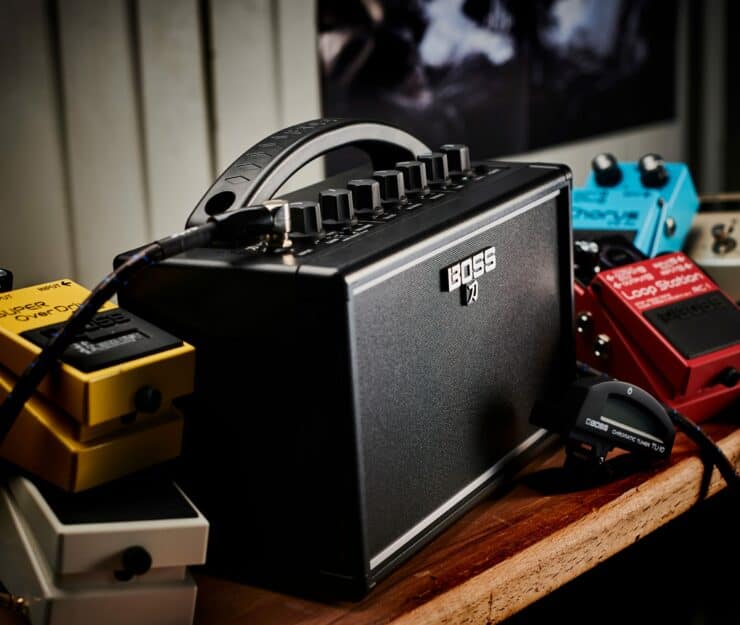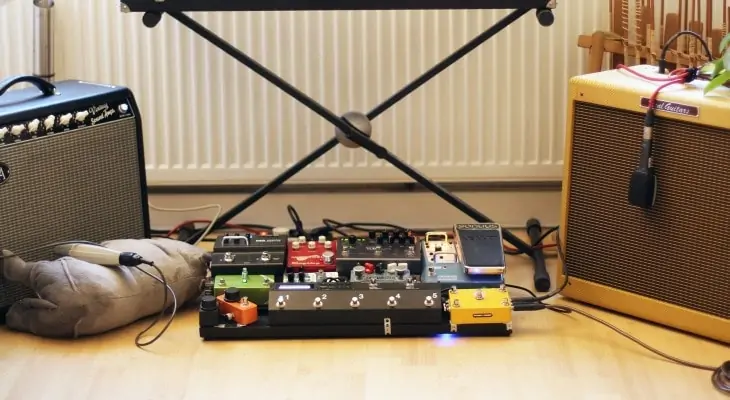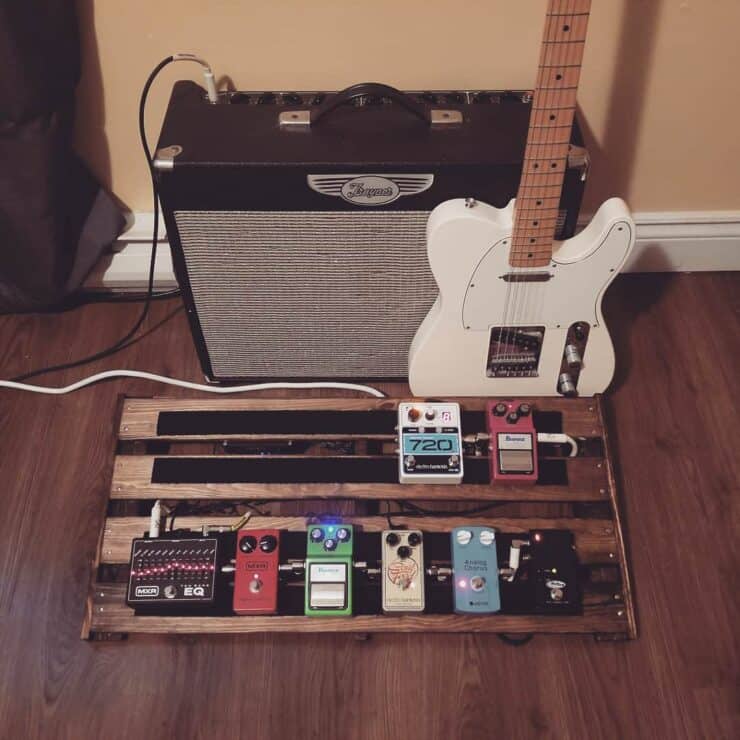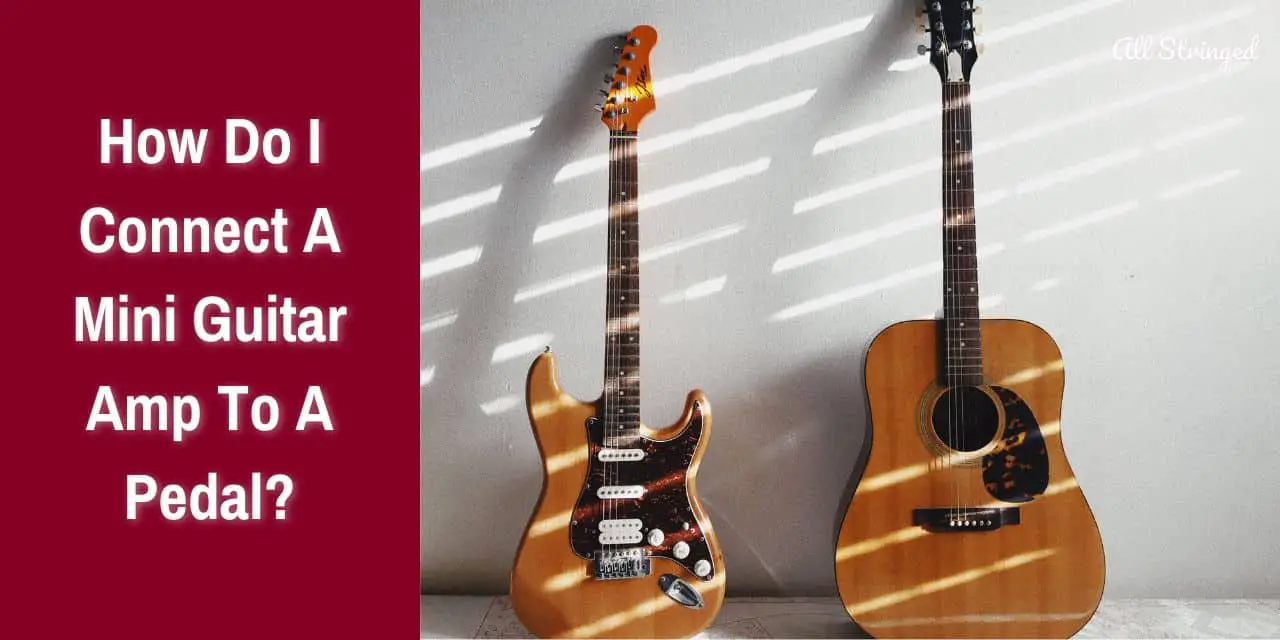Are you looking for the best way to connect your mini guitar amp to a pedal? As a guitarist, you know that the sound of your instrument is essential for your performance. In this article, we’ll discuss how to connect a mini guitar amp to a pedal so you can get the best possible sound. Whether you’re a beginner or a professional, this guide will help you get the most out of your amp and pedal. Let’s get started!
How does a mini guitar amp help you unleash your musical potential?
Mini guitar amps or also known as portable amps have recently become a game-changer in the world of music. These small yet powerful amps have become an important tool for musicians and guitarists looking for convenience, versatility, and top-notch sound quality.
Mini guitar amps are compact amps designed to provide a portable and lightweight solution for guitarists. They are significantly smaller than regular guitar amps and come in different sizes, ranging from pocket-sized models to small combo amps. Despite their diminutive size, these amps can produce impressive sound quality. This makes them ideal for practice, home use, small performances, and even small-scale recording. Brands like Boss, Vox, etc. have an impressive range of mini guitar amps to help you reach your potential.
>>> Click here to read our review about the Top 15 Best Mini Guitar Amps <<<
Here is how mini guitar amps can help you unleash your musical potential –
#1. High level of portability
Arguably, mini guitar amps are best known for their portability and convenience. These amps are designed to be lightweight and extremely easy to carry, which makes them perfect for musicians on the go. Whether you are heading for a rehearsal, jamming with friends, or performing in a small venue, mini guitar amps will allow you to play your music at all times. Their compact design ensures that they fit snugly in a backpack, making transportation very easy.

#2. A wide array of sound options
Despite their small size, these amps offer a wide array of sound options and features. Many mini guitar amp models come with built-in effects like delay, reverb, overdrive, and more, allowing you to experiment with different tones and styles. Some mini guitar amps also have amp modeling capabilities, replicating the sound of iconic amps from various eras. This versatility ensures you can achieve a wide range of sounds and tailor your tone to suit different musical genres.
#3. Helpful with small performances
Mini guitar amps might be compact but they aren’t limited to practice sessions. They are well-suited for small performances and intimate settings. Whether you are playing at a small venue, coffee shop, or busking on the streets, these amps provide enough power and sound quality to captivate your audience.
#4. Recording at home studios
Mini guitar amps also have a place in home recording studios. With direct outdoor options, these amps can be connected directly to a recording interface or mixing console. Many mini guitar amps have the option to be used as an audio interface, simplifying the recording process and ensuring high-quality sound for your tracks.
#5. Option to practice anywhere
Mini guitar amps serve as the perfect practice tool, allowing you to improve your skills anytime, anywhere. They often come equipped with headphone outputs, allowing you to practice silently without disturbing others. Whether you are a beginner learning the ropes or a seasoned player honing your craft, the ability to practice quietly fosters discipline and growth as a musician.
How do I connect a mini guitar amp to a pedal?
For musicians and guitarists, the combination of a mini guitar amp and a pedal can unlock a world of sonic possibilities. Whether you are seeking to add rich overdrive, ambient reverb, or lush modulation, connecting your mini guitar amp to a pedal is a simple process that can transform your sound. By connecting a pedal to your mini guitar amp, you’ll be able to shape your guitar’s sound and take things to a whole new level. Knowing how do I connect a mini guitar amp to a pedal will help make this process a whole lot easier. Here are the steps you need to follow to connect a mini guitar amp to a pedal, helping you achieve the perfect connection and unlock the full potential of your musical creativity.
Step 1: Gather your gear
Before you dive into the connection process, you need to gather the necessary gear including a mini guitar amp, pedals, and guitar cables. Make sure that your mini guitar amp is functioning correctly and that the power source is ready to go.
Choose the pedal that you want to connect to your mini guitar amp. Whether it is delay, distortion, chorus, or other effects, make sure it is in good working condition. Moreover, ensure that you have enough guitar cables to connect your pedal to the mini guitar amp. One cable will go from your guitar to the pedal while the other will go from the pedal to the amp.
Step 2: Set up the pedalboard
If you have multiple pedals that you’d like to use together, consider setting up a pedalboard. A pedalboard is an extremely convenient way to organize and power multiple pedals simultaneously. Arrange your pedals in the desired order, considering the signal flow, and secure them to the pedalboard.
Step 3: Prepare the amp and pedal
Before you start connecting your mini guitar amp to a pedal, it is important to ensure both the amp and pedal are in optimal condition. First, you should ensure that your mini guitar amp is powered on and functioning correctly. If it is a battery-powered amp, make sure that the batteries have sufficient charge. If you are using a regular power supply, verify that it is providing the correct voltage.
Check that your pedal is working correctly and that the batteries are charged. If you are using a power supply for the pedal, ensure it is compatible and supplying the necessary voltage. Before connecting, set both the amp and pedal to a neutral state. Turn off any built-in effects on the amp and set the pedal’s knobs to a flat or neutral position.
Step 4: Connect the amp and pedal
Once your mini guitar amp and pedal are prepared, you need to follow these steps to connect them together –
- On your mini guitar amp, you should locate the input jack, which will usually be labeled “input” or “in”
- Now, connect one end of the guitar cable to this input jack
- Connect the other end of the guitar cable to the input jack of the pedal
- The input jack on the pedal will typically be labeled “input” or “in”
- After that, connect another guitar cable from the output jack of the pedal (labeled “output” or “out”) to the input jack of the mini guitar amp
- Make sure that there is a secure connection for optimal signal transfer
Step 5: Test the connection
Once you have successfully connected your mini guitar amp to the pedal, it’ll be time to test the connection and make sure everything is working properly. First, power on both the mini guitar amp and the pedal. Check that the LED lights on the pedal are indicating that it is on and functioning.
With the mini guitar amp and pedal powered on, start playing your guitar. Listen for the effects of the pedal and make any necessary adjustments to the pedal’s knobs for achieving your desired sound.
If you hear no sound or experience a weak signal, you should double-check all connections and ensure everything is securely plugged in. Moreover, verify that the pedal’s battery or power supply is providing sufficient power.
Experiment with the pedal’s knobs to explore different sounds and effects. You should take note of the settings that you prefer for future reference.

Tips to remember when using a mini guitar amp
Mini guitar amps have truly revolutionized the way musicians and guitarists practice, perform, and record music. They have emerged as a portable and powerful solution for people looking for convenience without sacrificing sound quality. Despite their compact size, these miniature amps come packed with features that enhance your playing experience and they are capable of delivering impressive sound and offer a wide range of tones. However, to make the most of your mini guitar amps and achieve the best sounds, it is important to have a few tips and tricks. Here are some of the valuable tips that you must keep in mind for using a mini guitar amp to unlock its full potential and shape your desired sounds.
#1. Adjust the volume
One of the key aspects of using a mini guitar amp is finding the right volume level for your needs. You need to know how to adjust the volume in practice sessions, small performances, and recording to help you achieve the perfect balance. While mini guitar amps might not match the sheer volume of larger guitar amps, they still pack a punch. You should experiment with volume control to find the sweet spot that suits your playing style and environment.
Mini guitar amps are fantastic tools for practice due to their portability and headphone outputs. When practicing at home or in a noise-sensitive environment, you should take advantage of the headphone output to practice silently without disturbing others. Adjust the guitar amp’s volume to a comfortable level and let your creativity flow.
For small performances or intimate settings, you should adjust the volume to fill the space without overwhelming the audience. Mini guitar amps are perfect for coffee shop gigs, small venues, or acoustic performances. Experiment with the volume to find the right balance between clarity and projection.
When using your mini guitar amp for recording, you should adjust the volume to achieve the desired sound for your tracks. Remember that the microphone placement can also greatly impact the final recorded tone, so take the time to experiment with different positions.
#2. Utilize the amp for specific sounds
Mini guitar amps might be smaller but they can still offer an impressive array of sounds and tones. By utilizing the mini guitar amp, you’ll be able to get specific sounds like clean tones, overdriven tones, distorted tones, and more.
To achieve clean tones, you can start by setting the amp’s gain or volume control to a lower setting. Adjust the tone controls to taste, ensuring a balanced and clear sound. This setting will work well for genres like funk, jazz, and clean fingerpicking.
For classic overdriven tones, increase the gain or volume control to add a natural tube-like breakup. The amount of overdrive will depend on the guitar amp’s capabilities and the specific sound that you are seeking. Adjust the tone controls to shape the character of the overdrive, making it smooth and warm or gritty and biting.
If you are aiming for heavy distortion, you should crank up the gain control for a saturated and aggressive sound. Distorted tones are perfect r rock, metal, and punk genres. Experiment with the tone controls to fine-tune the distortion’s character to match your style.
Many mini guitar amps also come with built-in effects, such as reverb, chorus, delay, and more. You should take the time to explore these effects to add depth and dimension, experimenting with different settings. Adjust the effect level to your preference and use the amp’s controls to shape the effect’s parameters. These onboard effects can add depth and versatility to your sound, allowing you to create diverse tones without the need for external pedals. Embrace the creative freedom and use the built-in effects to shape your unique sonic identity.
#3. Embrace the portability
Portability is one of the biggest plus points of a mini guitar amp. You should take advantage of this feature by carrying your mini guitar amp with you wherever you go. Whether you are heading to a friend’s house, joining a jam session, or playing on the streets, your mini guitar amp can be your constant companion. Embrace the freedom of playing anywhere, anytime, and share your music with the world.
#4. Master the headphone output
Most mini guitar amps come equipped with a headphone output. This feature is a game-changer for private practice sessions, especially in noise-sensitive environments or late at night. You should embrace the headphone output and immerse yourself in your playing without disturbing others. It is the perfect way to fine-tune your skills and explore new techniques without limitations.
#5. Customize your tone
Even with a smaller size, mini guitar amps offer tone-shaping capabilities. You should explore the guitar amp’s EQ controls (bass, treble, and midrange) to find your preferred sound. Whether you are aiming for warm and smooth cleans or gritty overdriven tones, these controls will help you achieve the desired character. You should embrace the process of fine-tuning your tone to match your musical style and preferences.
#6. Experiment with mic placement
If you’re planning on using your mini guitar amp for recording, you should consider experimenting with microphone placement. Placing the microphone closer to the amp’s speaker cone will yield a brighter and more focused sound. Meanwhile, moving it further away can result in a more ambient and roomy tone. You should be embracing the creativity of recording and find the mic placement that best captures the essence of your sound.
#7. Combine with effects pedals
While mini guitar amps offer a wide variety of tones and effects, you can also complement your sound with external pedals. Whether you are seeking specific distortions, modulation effects, or unique textures, adding pedals to your setup can expand your sonic palette. Moreover, you should experiment with different pedal combinations to find the perfect balance that enhances your playing style.

Different types of mini guitar amps
Mini guitar amps have become a popular option among musicians and guitarists looking for portability, convenience, and top-notch sound quality. Despite their compact size, these amps come in various types, each offering unique features and characteristics. Here are the different types of min guitar amps and their characteristics, helping you choose the perfect match for your musical needs.
Solid-state mini guitar amps
Solid-state mini guitar amps make use of semiconductor electronics for amplification. These amps are known for their reliability, durability, and straightforward design. They are ideal for guitarists looking for clean and transparent tones, making them versatile for various playing styles.
Solid-state maps have no fragile tubes to worry about. This makes them more robust and suitable for musicians who frequently travel or perform on the go. Solid-state technology ensures a consistent tone, which can be advantageous for recording or live performances that require a predictable sound.
Tube mini guitar amps
Tube mini guitar amps are beloved for their classic warm and rich tone. These amps make use of vacuum tubes to amplify the guitar signal, providing harmonic overtones and dynamic responsiveness that many guitarists adore.
Tube amps are renowned for their organic and vintage sound. They excel in producing warm cleans and saturated overdriven tones, ideal for jazz, blues, and classic rock styles. Tube amps respond to the player’s touch and playing dynamics, providing a more expressive and sensitive playing experience.
Digital modeling mini guitar amps
Digital modeling mini guitar amps employ advanced digital signal processing to emulate the sound of various amps and effects. These types of guitar amps offer a wide selection of amp models and effects, making them a favorite choice for guitarists who crave versatility.
Digital modeling amps can replicate the sounds of numerous amps and effects, allowing you to explore various genres and styles without requiring multiple amps and pedals. Many digital modeling amps also come equipped with a wide range of built-in effects, such as delay, reverb, modulation, and more, reducing the need for additional pedals and simplifying your setup.
Hybrid mini guitar amps
Hybrid mini guitar amps combine the qualities of solid-state and tube technology. These guitar amps often feature a tube in the preamp section for warmth and tone-shaping capabilities, paired with solid-state components for the power amp section, providing reliability and efficiency.
Hybrid guitar amps offer the warmth and character of tubes in the preamp stage while maintaining the durability and consistency of solid-state technology in the power amp section. Many hybrid guitar amps come with built-in effects and versatile tonal controls, allowing you to explore a wide range of sounds with ease.
FAQs
What do I need to connect a mini guitar amp to a pedal?
In order to connect a mini guitar amp to a pedal, you will need an instrument cable, a patch cable, and a pedal power supply. The instrument cable will connect your guitar to the amp, the patch cable will connect the amp to the pedal, and the pedal power supply will provide power to the pedal.
What type of pedal power supply should I use?
When choosing a pedal power supply, you should consider the type and number of pedals you will be connecting. A good rule of thumb is to use a power supply with a higher voltage and current rating than the pedals you will be connecting. This will ensure that the pedals receive enough power and will help to prevent any damage to the pedals or the amp.
What are some safety tips for connecting a mini guitar amp to a pedal?
When connecting a mini guitar amp to a pedal, it is important to pay attention to safety. Make sure the power supply and cables you are using are in good working condition and the connections are securely made. Avoid touching any exposed wires and make sure the power supply is powered off when making connections. Additionally, never leave the power supply connected and unattended.



